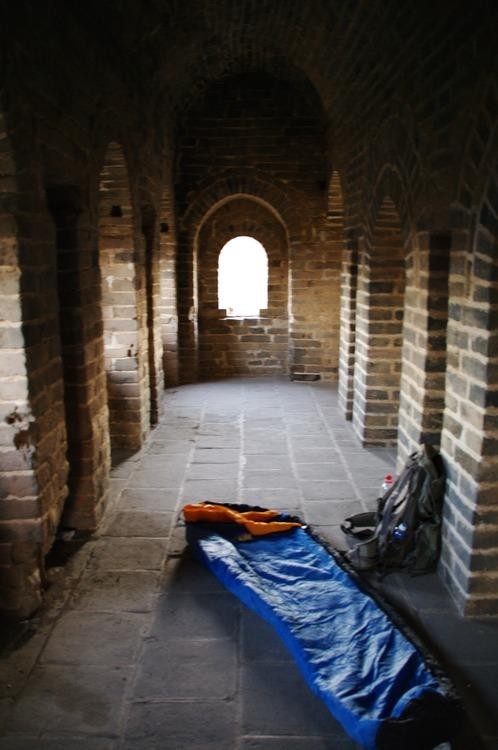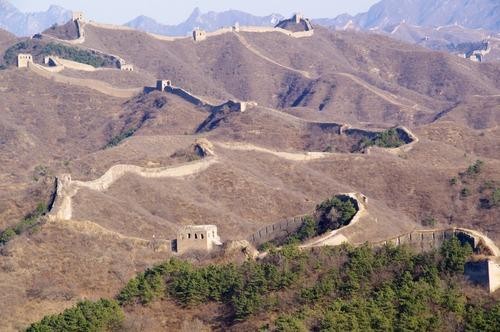I Hacked the Hidden Great Wall With My Smartphone—You Can, Too

Standing alone in a field in rural northeast China, I was utterly and hopelessly lost.
With a carbon hiking pole in
each hand and an LED headlamp strapped to my head, I must have looked
like a space alien to the farmers tending to their morning chores. An
old woman with a dull hoe slung across her shoulder shot me a wild,
confused stare. A group of men taking turns chopping wood glared at me
until one of them shouted in harshly accented Chinese.
“What are you doing here?” one of the men asked.
“Searching for the Great Wall of China,” I replied in Mandarin.
The men looked at one another with blank expressions, quickly scanning the empty ridges above to show me, without speaking, that there was no Great Wall here.
“What are you doing here?” one of the men asked.
“Searching for the Great Wall of China,” I replied in Mandarin.
The men looked at one another with blank expressions, quickly scanning the empty ridges above to show me, without speaking, that there was no Great Wall here.
That’s when I pulled out my smartphone. Before I left on my journey to hike alone along China’s Great Wall, I tapped into an online network of travelers
who had blazed their own trails along the wall, and recorded the GPS
coordinates of the important turns and twists along the way. I used
these strangers’ guidance to find my way to a remote, unrestored section
of the wall just a few hours outside Beijing.
The coordinates showed that I was nearly two miles off course, heading
away from the wall and into unknown countryside. I turned around,
followed the blue line on my phone’s screen, and was back on track.
For those searching for an
authentic Great Wall trek far from tourists and tour guides, there is an
entire infrastructure online devoted to hunting down the quietest and
most remote sections. With just a little digging, I found a route that
fit my schedule and skill level, complete with a digitally mapped trail
leading from the neglected but hauntingly beautiful Gubeikuo section to
the slightly crowded, but much more tourist-friendly Jinshanling.

The crowd-sourced directions led
me to a section of the wall that was crumbling at its corners and
overgrown with vegetation. This was, as the hikers online dubbed it, the
“wild” wall. Despite being only a few hours from Beijing, it’s a site
that most day-trippers and tourists never see. And I had it all to
myself.
The stretch I hiked runs for
approximately eight miles. Without my little detour, it can be traversed
in a single day. I, however, had planned on getting lost.
Once on the wall, I hiked until
near sundown, mindful of the condition of the watchtowers I passed
through every few hundred yards. Finally, with the sun turning a hazy
orange, I found a spot to unroll my sleeping bag.

(Photo: Micah Spangler)
Night quickly descended and the
air plunged into the mid 30s. I soon remembered that my bag was rated
for somewhere around 45 degrees. With only an inch of polymer down
between the stone floor and me, I tossed and turned. In sporadic bursts
the wind whipped through the windowless tower, sending strange sounds
echoing through the hills and waking me from my mild slumber. This was
something my Great Wall forum friends could not help me with.
I woke just before dawn, my
frigid back all too sensitive to a change in the floor’s temperature. To
the east, above a narrow watchtower-topped hill, the sun began to peak.
I scrambled up the cracked, sloping ridge and looked north. Farmers in
the distance were already out, seeding the ground by hand. Nothing about
the scene said 2014; for all I knew I had awakened five centuries in
the past.
That is, until I powered my
phone back on and checked the next set of coordinates. I had four miles
to go, but felt no rush. The wild wall wasn’t going anywhere.

Plan your own Great Wall adventure:
• For more information on my specific hike, check out this post on the Great Wall Forum website.• To reach Gubeikou from central Beijing, take the subway to Dongzhimen station. Follow the signs to the bus terminal and board the 980 bus to Miyun. To shorten your trip, make sure to take the express bus, which is denoted with 快—the Chinese character for “fast”.
• Once you arrive in Miyun you
have two choices to reach the Great Wall: you can take the local 25 bus
or catch a taxi. The 25 bus runs fairly often but you may end up waiting
an hour or more for it to arrive. If you’re crunched for time, opt for a
taxi. A ride to Gubeikou should cost no more that 200 CNY ($32 USD).
• Once you complete your hike
and arrive in Jinshanling, take a taxi back to the Miyun bus station
where you can board the 980 bus back to Beijing.
Micah Spangler lives in Washington, DC. He has traveled to over 20 countries on six continents.
-------------------------------------------------------------------------
